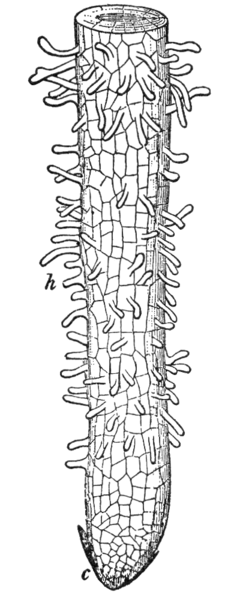Anatomy of a Root: Longitudinal Section
A plant root is an organ, and like all organs (plant or animal), has specialised regions marked by specialised tissue. This post outlines these, with an emphasis on the longitudinal section (a cut along the long axis) of a young, growing root. Next week we’ll discuss the regions and tissues in a cross-section (a cut at right angles to the longitudinal).
Specialised Regions of a Root
The specialised regions of a root are the
- root cap (c in Figure 1 and 2 in Figure 2 below),
- division zone immediately behind and within the root cap (1 in Figure 2 below),
- elongation zone (5 in Figure 2 below), and the
- maturation zone (includes the root hairs, h in Figure 1 below)

Attribution: This image is in the public domain and comes from Wikimedia Commons via an original image scanned by User:LA2 in October 2005

Attribution: SuperManu / CC BY-SA (https://creativecommons.org/licenses/by-sa/2.5)
Root Cap
The root cap protects the end of the root as it moves through soil. Movement is aided by two actions of the cap. One is by the secretion of mucilage, a thick glue-like substance that lubricates the root tip as it pushes through the soil. The other is via production of carbon dioxide (CO2), which reacts with water in the soil to form a weak acid called carbonc acid (H2CO3). This acid dissolves some soil particles, which further makes it easier for the tip to push its way through.
The cap is comprised of a group of cells known as columellae (plural form of columella, column). (This has three meanings in botany, one of which specifically describes the longitudinal alignment of cells in the root cap — botany can be so precise!).
These columns are made of statocytes, cells which detect gravity via their organelles* the statoliths — removing a root cap causes the root to grow in random directions.
*An organelle is a cellular subunit — better-known examples include nuclei, chloroplasts and mitochondria.
The statoliths fill with starch and, being denser than cytoplasm, sink and deposit at the lowest part of the statocytes. This deposition initiates pathways that direct the root to downwards growth.
In addition to helping the root cap push through soil, mucilage also attracts beneficial microbes to the rhizosphere, prevents root cells from drying out, and glues soil particles to the root which aids in water and nutrient uptake. Mucilage can also contain compounds that inhibit the root growth of other species.
Root caps can also detect light and soil pressure to direct growth away and down into the soil, and can detect barriers and direct growth around those.
Division Zone
The division zone comprises the meristem and is a highly compact region, and together with the root cap is a centimetre or less in length. This is the growing region immediately behind the root cap and the columellae, and where new root cells are formed — only the root cap and the division zone of growing, dividing cells move through the soil.
Elongation Zone
In the elongation zone cells do not divide, but instead elongate to lengthen the root. This action also pushes the root tip through the soil. Further extension of this part of the root is no longer possible when these cells finish elongation and mature, and this section of root becomes stationary from this point on. A new elongation zone arises further down towards the root tip as a new group of cells develop behind the advancing division zone and the process repeats.
Maturation Zone
The maturation zone is marked by the development of root hairs — tiny extensions which increase a root’s surface area significantly and allow for higher absorption of water and nutrients, much as the microvilli in animal guts do. Root cells in this zone are no longer dividing but do grow bigger, causing the roots to thicken. Root hairs have a lifespan of a day or two, and break down at the proximal (plant) end of the maturation zone as new ones grow at the distal (tip) end. Lateral (side) root development also occurs at the proximal end.
About the Author
BSc(Hons), U.Syd. - double major in biochemistry and microbiology, with honours in microbiology
PhD, U.Syd - soil microbiology
Stumbled into IT and publishing of all things.
Discovered jujube trees and realised that perhaps I should have been an agronomist...
So I combined all the above passions and interests into this website and its blog and manuals, on which I write about botany, soil chemistry, soil microbiology and biochemistry - and yes, jujubes too!
Please help me buy a plant if you found this article interesting or useful!